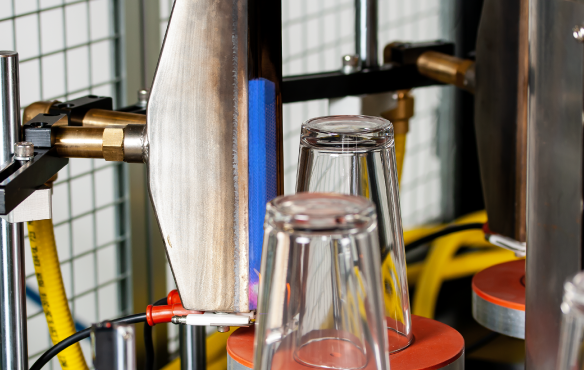
Do you have a favorite glass or cup you always reach for in the cabinet? Have you ever considered how many washes it has been through? Yet despite having it for years, the design remains just as it did the day you brought it home. Now consider a glass or cup you brought home from an event and ran through the dishwasher once and the design melted off. What is at fault for the short lifespan of this drinkware? What is to credit for the long lifespan of the first drinkware? Flame treatment for adhesion can make all the difference when it comes to a long and vibrant lifespan of digitally printed ink.
Flame treatment for adhesion is the process of taking a gas flame to the surface of a substrate to change the surface tension. Some types of glass, plastic, and polymers consist of long non-polar molecules. By quickly taking a gas flame to the surface of these materials, one can break down molecular chains and add polar functional groups.
For example, popular substrates such as polypropylene and polyethylene have low surface tension, so a flame treatment can alter and increase the surface tension.
The flame must be blue to begin the flame treatment. It has two parts; the primary which is the light blue inner cone, and the secondary which is the dark blue outer cone. The blue color of the flame means that the ratio of fuel to air is gas lean, which in turn is oxidizing. The surface tension of your substrate will only be correctly manipulated if the flame is oxidizing.
The flame is applied to the surface of the substrate quickly, evenly, and in motion thus preventing the substrate itself from melting.
Inkcups offers two flame treatment machines, the AutoFlame 360 and the MagiCoat Pre-Treatment System.
Inkcups offers the AutoFlame 360 flame treatment machine for cylindrical drinkware. An operator loads each drinkware onto eight different vacuum sealed palettes. From there, each bottle (or drinkware of choice) visits the adjustable flame which can be up to 12″ high while it is rotated 360-degrees to evenly treat the entire surface. Once the bottle has been treated by the flame and traveled around the entire unit it is lightly tapped by a hydraulic system into a box or bin ensuring it does not pass by the flame for a second time.
The AutoFlame 360 can accommodate both straight wall and tapered products with its angular burner adjustment feature.
The second option that Inkcups offers for flame treatment is the MagiCoat Pre-Treatment System. This system begins with the same mechanics as the AutoFlame 360 plus the addition of the fine mist spraying system for spray on primers. An operator individually loads each piece of drinkware onto eight palettes. Each palette rotates 360-degrees at each stop, one of which is at the flame, another of which is at the MagiCoat primer station. Upon completion of the full rotation around the MagiCoat machine an operator must manually remove each piece of drinkware. The MagiCoat is specifically for glass drinkware thus the need for manual retrieval due to the breakable nature of the substrate.
Not all substrates will need to be flame-treated. This decision comes down to a few factors:
One common misconception when it comes to UV printing is that there is a universal ink for all substrates. This is completely false. Not one ink can stick to multiple substrates. This is proven with other methods of decorating and labeling such as pad printing and screen printing. That being said, there are some inks that will stick to multiple substrates but just with a little help. If you want to switch substrates but not all
Depending on the inkjet primer, some will help with adhesion without flaming needed. For example, the XF Primer for Powder Coated Vessels adheres to powder coated substrates without flame needed. This primer was made for this product and therefore, does not need additional help to get ink to stick.
There are also instances where adhesion requirements negate the need for flame-treatment or will encourage flame-treatment. Some items that are more for promotion rather than retail may have different requirements.
Are you ready to add a flame treatment process to your business? Contact the sales representative in your area today.
Back to Blog Home
Add Your Comment